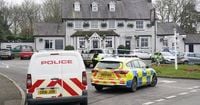On Valentine’s Day 2025, a tragic sequence of events unfolded in the quiet village of Knockholt, Kent, ending with the death of 43-year-old Lisa Smith at the hands of her estranged husband, Edward Smith. What began as a desperate attempt to escape a troubled marriage became a chilling reminder of the dangers faced by those seeking to leave abusive relationships—a story that has since gripped the nation and prompted urgent questions about the effectiveness of support systems for victims of domestic violence.
According to multiple reports from Sky News, BBC, and other local outlets, Lisa Smith had spent the hours leading up to her death trying to secure her safety. She had informed her sister, Samantha Graham, that she intended to leave Edward Smith, and boarded a train from their home in Slough to Kent, where she planned to stay with family. Friends and relatives rallied around her, picking her up at Orpington station at around 2:40 pm and driving her to The Three Horseshoes pub—a seemingly ordinary gathering place that would soon become the scene of unimaginable violence.
Throughout the afternoon, the group kept a low profile, acutely aware that Edward Smith was searching for Lisa. He had been repeatedly calling one of her friends, attempting to track down her whereabouts. Just before 7:00 pm, Edward appeared at the pub, shouting for Lisa and creating a tense confrontation. A friend of Lisa’s tried to intercept him, reportedly calling him a “narcissist” and referencing his past behavior. CCTV footage later confirmed the verbal altercation inside the pub, after which Edward returned to his car and drove away—at least, momentarily.
Lisa, accompanied by two friends, slipped out the back of the pub and got into a friend’s car, hoping to make a quiet exit. But within moments, Edward Smith reversed his vehicle and blocked their path, trapping them in the car park. What happened next was both swift and devastating: Edward fired four shots from his handgun in less than two minutes. The first two shots were discharged from inside his own vehicle, causing no injuries consistent with their trajectory, as later confirmed by coroner Katrina Hepburn. He then exited his car, approached the driver’s side, and fired a third shot through the window—this bullet inflicted fatal damage to Lisa’s neck. A fourth shot, delivered at close range from the passenger side, ensured there was no hope of survival.
Despite the immediate intervention of an off-duty firefighter who was drinking in the pub at the time, and the frantic efforts of emergency services, Lisa Smith was declared dead at 7:42 pm. The post-mortem would later reveal that she had been struck twice in the neck and once in the chest, but it was the third shot that proved fatal.
After the shooting, Edward Smith’s actions grew increasingly erratic and desperate. BBC reports detail how he fled the scene, driving to a nearby fish and chip shop where he brandished his handgun and demanded a knife. He then sent a series of voice notes to relatives and acquaintances, admitting to the shooting and alluding to his own impending suicide. In one message, he said: “We have a little bit of a tragedy today. I have just shot my wife, Lisa. If you could pray for my family, as things are not looking good.” In another, he confessed: “All my family is trying to call me. I have shot Lisa; she is dead. Probably the police are going to shoot me, so I am going to go. I will see you on the other side. Pray for me, and hopefully I will get into heaven with my wife.”
Edward’s mental state in the days and weeks leading up to the shooting was also addressed during the inquest. The court heard from his GP, who described previous appointments for mental health concerns, including a diagnosis of non-organic psychosis and a history of being sectioned around a decade prior. While Edward had reported feeling better after receiving medication earlier in the year, he had also confided in his doctor about ongoing arguments with Lisa and her temporary departure over Christmas, citing her inability to cope any longer.
After leaving the pub, Edward drove toward the Queen Elizabeth II Bridge in Dartford. Police launched a manhunt, utilizing CCTV, automatic number plate recognition (ANPR), and phone tracing, but were unable to intercept him before tragedy struck again. Witnesses later described seeing a man in a light-colored tracksuit standing on the wrong side of the bridge’s safety barrier. He was then seen falling into the River Thames below. Edward’s body was not recovered until March 7, when it was found in Coldharbour Lane, Rainham, Essex. The cause of death was determined to be massive head trauma, and the coroner concluded it was a clear case of suicide.
The inquest, held at Oakwood House in Maidstone on September 17, 2025, left little doubt about the sequence of events or the intent behind them. Area coroner Katrina Hepburn was unequivocal in her findings: “I am satisfied on the balance of probabilities that a short form conclusion of unlawful killing would be safe and appropriate to set out in this manner. There was intent to find Lisa Smith after she had left her home address and once she was found the car she was seated in was blocked, preventing any exit.” She further stated, “There was requisite intent from Edward Smith to kill her or cause her really serious harm.”
The court also heard poignant tributes from Lisa’s family. Her son, Teejay, remembered her as “the best,” adding, “My dear old mum, never be another to walk in her shoes.” Others sent prayers and condolences, particularly for Lisa’s sons and her young granddaughter, underscoring the profound loss felt by those closest to her.
In the aftermath, the case has sparked renewed calls for improved safeguards for individuals attempting to leave abusive or controlling relationships. The rapid escalation of violence, despite Lisa’s efforts to seek safety and the involvement of friends and family, has prompted questions about the adequacy of current support mechanisms and law enforcement responses in such high-risk situations.
Lisa Smith’s story is a stark reminder of how quickly domestic violence can turn fatal, even when victims take brave and decisive steps to protect themselves. Her death, and the subsequent suicide of Edward Smith, have left a community in mourning and a family grappling with the loss of a beloved mother and grandmother. As the inquest concluded, the facts were laid bare for all to see—yet the human cost remains immeasurable, echoing far beyond the car park of a Kentish pub on a February evening.


